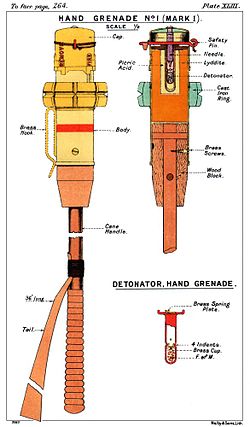- No 1 Grenade
-
No 1 Grenade 
Hand Grenade No I Mark IType Hand grenade Place of origin  United Kingdom
United KingdomService history Used by United Kingdom Wars World War I Production history Designer Royal Laboratories Designed 1908 Produced 1908-1915 Variants No. 3 (shorter handle), No 18 (different detonator) Specifications Weight 2 lb[1] Filling Lyddite[1] Detonation
mechanismPercussion fuse (ie. impact detonated) The Grenade, Hand No 1 was the first British hand grenade used in World War I.
Overview
The Grenade No 1 was designed in the Royal Laboratory and is based on reports of Japanese hand grenades during the Russo-Japanese War by General Sir Aylmer Haldane, who was a British observer of the Russo-Japanese War and brought back a few samples of Japanese grenades. [2]
The grenade proper is a can of explosive material with an iron fragmentation band. The fuse was of the impact sort, detonating when the top of the grenade hit the ground. A long cane handle (approximately 16 inches) allowed the user to throw the grenade further than the blast of the explosion.
To ensure that the grenade hit the ground nose first, a cloth streamer was attached to the end of the handle. When thrown this unfurled and acted as a tail to stabilize flight.
When the battlefield became confined to the trenches, the long handle became a liability - several accidents occurred when reaching back for the throw, the fuse struck the trench side. [3] The no. 3, a variant of the No 1 with a shorter handle, was made to make it easier to throw in a trench.
Even with these adjustments, the No 1 and its variants did poorly in battle. According to German prisoners captured at Ypres in January 1916, the No 1 could be deflected by wooden boards. In some cases, the deflected grenade could be thrown back.[4]
Manufacturing the No 1 was difficult as well, as it required a special detonator that could only be produced by the Ordinance Factories. Because of this, there were far fewer No 1s sent to the BEF than were ordered. [5] A version that used a more common detonator, the No 18, was designed, but by then battlefield experience had shown that the No 1 design was ineffective.
The difficulty of operating it in trenches plus the special detonator caused Britain to create several stopgap grenades, such as the Jam Tin Grenade, until the Mills Bomb was adopted.[6]
The grenade came with a metal loop so it could hang from the belt.
References
Anti-personnel Grenade, No 1 · No 2 grenade "Hales Pattern" · Nos. 3, 20, 24, 35 "Hales Rifle Grenade" · Nos. 5, 23, 36 Mills · No. 6 grenade · No. 15 Ball grenade · No. 69 · Nos. 8, 9 Double Cylinder Jam TinAnti-tank Special Types 
This article related to weaponry is a stub. You can help Wikipedia by expanding it.
